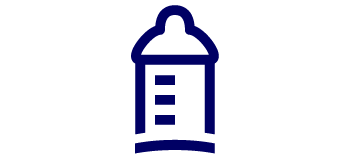Breastfeeding comes with a slew of benefits for babies, including healthy nutrition, lower rates of asthma and allergies, and a lower risk of childhood obesity and Sudden Infant Death Syndrome (SIDS). On top of that, breastfeeding also benefits mothers.
Given all the positives, you might expect breastfeeding to come easily. After all, what’s more natural than feeding your baby? But the truth is, breastfeeding challenges are all too common.
If you’re struggling, remember: Breastfeeding is a skill that can take time to learn. “Breastfeeding is a confidence game,” says Gayle Yerge-Cole, RNC, IBCLC, a lactation consultant at Henry Ford Health. With practice and support, you can find ways to overcome the feeding friction.
Common Reasons for Difficulty Breastfeeding
Nursing moms can experience a variety of problems that make breastfeeding harder. Some challenges include:

Find A Lactation Consultant At Henry Ford
- Nipple pain: Some tenderness or sensitivity is common as you get used to nursing. But pain is a sign of another issue.
- Latching and positioning difficulty: Nipple pain often happens when the baby isn’t positioned correctly at the breast. A shallow latch can cause the nipple to become pinched and irritated. It also makes it hard for the baby to drink enough milk.
- Tongue tie: A tongue tie is a condition that occurs when extra tissue connects the tongue to the bottom of the mouth. It can interfere with nursing, but many babies with tongue ties can breastfeed successfully.
- Plugged ducts: Sometimes a milk duct doesn’t drain correctly because the walls of the duct become inflamed. Milk can build up in the breast, causing a lump that’s painful or tender.
- Mastitis: Mastitis is inflammation of the breast tissue. It can cause painful, warm breasts or flu-like symptoms.
- Thrush: Thrush is caused by a fungal (yeast) infection. It can cause nipples to become pink, cracked, blistered or painful.
- Milk supply: Some women have trouble producing enough milk to feed their growing baby.
Overcome Breastfeeding Challenges
Breastfeeding problems are common—but they are also commonly overcome. “As long as mom and baby are healthy, you can do this,” Yerge-Cole says. She shares advice for getting past the common hurdles.
- Plan ahead. Knowing what to expect can go a long way toward a successful breastfeeding experience. Consider taking a class or meeting with a lactation consultant to learn about breastfeeding before your due date, Yerge-Cole recommends. After delivery, ask for support and advice from nurses and lactation specialists. “Take advantage of the short time you have in the hospital to make sure you have the tools and skills you need before you head home,” she says.
- Enlist help. If you have a co-parent or supportive family member, include them in breastfeeding education. When they are up to speed on the basics, they’ll be better able to assist and support you. “Your family should be your cheerleader,” Yerge-Cole says.
- Don’t wait. “Milk supply is all about the first few days and weeks,” Yerge-Cole says. After you give birth, a hormone called prolactin triggers your body to produce milk. If you don’t start removing milk, prolactin levels drop quickly. Once that happens, it can be hard to get the hormone to rise again—a problem that can lead to low milk supply. “It’s really critical to remove milk from the breast in the first two to six hours after birth,” she adds. If your newborn is having trouble nursing, you might need to express milk manually using your hand or a pump. A nurse or lactation specialist can help.
- Look at the latch. When it comes to breastfeeding, a good latch is essential. A poor latch can cause nipple pain and prevent the baby from feeding efficiently. “Breastfeeding shouldn’t be painful,” she adds. “If it is, reach out to a healthcare provider who can help you make sure the baby is positioned correctly, latching deeply, and transferring milk with frequent swallowing.”
- Feed on demand and don’t skip feedings. “To maintain your milk supply, it’s important not to miss feedings,” Yerge-Cole says. She recommends removing milk at least 8 times in a 24-hour period, either by nursing when your baby is hungry or by pumping. Try not to go more than 5 or 6 hours between sessions.
- Pump with care. Pumping milk is a great way to remove milk when you’re away from your baby and build a supply for future feedings. But don’t overdo it. “It can be a badge of honor to have a refrigerator full of breastmilk. But pumping too often can lead to overproduction, which can cause mastitis,” she explains. “It’s great to have a little extra supply on hand, but be cautious about constant pumping.”
- Avoid deep breast massage. Old-school recommendations advised women to massage their breasts to relieve a plugged milk duct. Now, experts recognize that deep massage can cause inflammation, which can lead to problems including mastitis and plugged ducts. “You don’t need to deeply massage the breast tissue,” she says. “To stimulate milk to release from the glands, just stroke the breast lightly with your fingertips, as though you’re putting on lotion.”
- Talk to your provider. “Make sure you have a doctor who is supportive of breastfeeding,” Yerge-Cole adds. If you’re struggling, be honest. And talk to your provider right away if you have nipple pain, signs of infection or plugged ducts, or concerns about a possible tongue-tie or latch issue. Your doctor wants you and your baby to be healthy and can recommend resources to get you on track.
Reviewed by Gayle Yerge-Cole, RNC, IBCLC, a lactation consultant at Henry Ford West Bloomfield Hospital.



